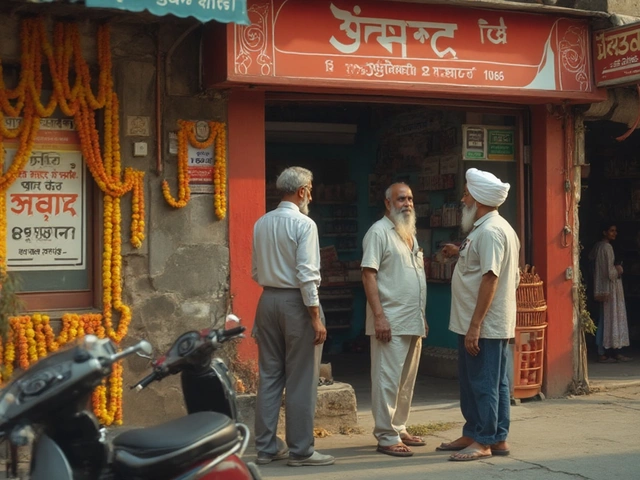
Ever wondered what happens to all that gold jewellery sitting quietly in your cupboard? In India, it’s not just for show. Families use gold as a financial backup, especially during emergencies or when cash flow gets tight. Indians have over 27,000 tonnes of gold, which is more than what most central banks hold. And with the way gold prices have soared in the last decade, a gold loan isn’t just for crisis—it’s a clever way to unlock value without selling your sentimental pieces. But here’s the kicker: the gold loan rate in India isn’t fixed—it jumps up and down depending on lenders, gold prices, RBI policies, and how much gold you’re putting on the table. If you’re eyeing a gold loan, you’re probably not just making a split-second decision. There are hidden charges, surprise regulations, and new-age lenders offering something different every month. Let’s break down what really matters in 2025, and help you spot the best deal that won’t leave you regretting the decision next year.
How Gold Loan Rates Work in India
Gold loan rates aren’t plucked out of thin air—they’re usually linked to what’s called the MCLR (Marginal Cost of Funds-based Lending Rate). This is the minimum rate below which a bank can’t lend. Now, add a little extra margin—the bank’s processing fee, risk premium, and a bit of profit. In 2025, most Indian banks and NBFCs (Non-Banking Financial Companies) are charging gold loan rates anywhere from 8% to 17% per annum. The average, as of July this year, sits at around 10.5%. Public sector banks usually stick close to the lower range; private banks or big NBFCs run a bit higher. But there’s more: some online platforms like Rupeek, Muthoot, Manappuram, and IIFL shave off up to 1% if you’re a regular customer or have a solid repayment record.
Gold loan amounts are based on the value of the gold you pledge—not on your income. The Reserve Bank of India has strict rules here: since August 2020, banks can lend up to 75% of the gold’s market value (Loan-to-Value or LTV ratio). So, if you put up gold worth ₹1 lakh, the bank can lend you up to ₹75,000. Anything beyond that is not allowed. This cap protects both lenders and borrowers—otherwise, a big drop in gold price would spell disaster.
But here’s an interesting twist: the gold loan market adjusts rates faster than personal loans. If gold prices go up this year, you could get a bigger loan on the same gold. Still, the interest rate will depend more on the bank’s assessment, your relationship with them, and how desperate you are for the funds. Banks love low-risk, easily recoverable loans—so they give gold loans at lower rates than unsecured loans, because if you default, they auction the gold and recover the cash, usually without much drama.
Some statistics worth noting. The gold loan market in India crossed ₹6.3 trillion ($76 billion) in total outstanding loans by mid-2025. Large NBFCs like Muthoot Finance and Manappuram control about 60% of the organised sector, while the informal gold loan market (pawnshops, local moneylenders) is still huge, possibly as big as the official sector. But do yourself a favour—avoid the unlicensed guys unless you enjoy stress, surprise charges, and zero paperwork.
| Lender | Gold Loan Interest Rate (Per Annum) | Processing Fee |
|---|---|---|
| State Bank of India (SBI) | 8.65% - 10.25% | 0.25% (Min. ₹500) |
| HDFC Bank | 9.00% - 16.25% | Up to 1% |
| Punjab National Bank | 8.90% - 9.75% | 0.70% (Min. ₹500) |
| Muthoot Finance | 12.00% - 21.00% | Up to 1% |
| Manappuram Finance | 12.00% - 18.00% | Up to 1% |
| ICICI Bank | 10.00% - 16.50% | 1% |
| Rupeek | 8.88% - 14.00% | Zero |
Comparing Gold Loan Rates: Banks vs NBFCs vs Online Platforms
The temptation to walk into your nearest NBFC or pawnshop is understandable. It’s quick, transaction is friendly, no one judges your credit score or asks for salary slips. But don’t get lazy—a few percentage points difference in rates could add up to thousands of rupees, especially for big-ticket loans. Public sector banks like SBI and Punjab National Bank tend to offer the lowest rates: sometimes as low as 8.65% per year. The flip side? More paperwork, slower processing, and less leeway if your gold is of “non-standard” make.
Private sector banks like HDFC and ICICI sit in the middle ground—faster than public banks, usually more flexible with repayment options, and offer digital application processes that save you from making trips to the branch. NBFCs like Muthoot, Manappuram, and IIFL have built an empire by making gold loans effortless—no-fuss documentation, instant disbursal (sometimes in under 30 minutes), and outlets in most small towns. But here’s the catch: rates are often 12% or higher, and processing fees can nibble off a chunk of your loan value.
Online players like Rupeek or Oro promise more transparency and quick doorstep service. They let you apply online, pick up the gold from your home, and drop it back when the loan is cleared. Their rates, at least right now, are competitive—sometimes even undercutting both NBFCs and private banks, thanks to lower overhead costs. In 2025, these app-driven gold loan companies are pulling young and tech-savvy borrowers their way, especially in metro cities.
Here’s a tip: don’t just compare interest rates. Check the processing fees, foreclosure charges, overdue interest (penalty if you miss payments), valuation methods (some banks use lower international rates), and, most importantly, how safe your gold is while in storage. The insurance offered on pledged gold varies from one lender to another, with some offering full cover and others sticking to the LTV value only. If you’re pledging family heirlooms, ask for written proof of insurance and check the fine print before signing anything.
Pro tip I learned the hard way when my cousin needed quick funds for a medical emergency—don’t go for the “schemes” that look too good to be true. Anything with zero interest for the first month or super-low rates is usually offset by fat processing fees or sky-high rates if you miss a payment. Calculate the total outgo, not just the advertised rate. Lenders are betting you won’t read the fine print.
And keep an eye on seasonal offers. Festivals, wedding seasons, and financial year-ends are when banks slash rates or waive certain charges to attract more customers. If your requirement isn’t urgent, waiting a few weeks could save you real money. Track the lender’s website for fresh offers and read up on customer reviews before choosing.

Gold Loan Eligibility, Documents, and Process
The good part about gold loans is you don’t need to be some salaried executive or have a six-figure income. As long as you own gold (and yes, even gold coins count up to a limit), you’re eligible. Most lenders in India accept gold jewellery between 18 and 24 karat. The purer the gold, the higher the loan amount you get, as lenders only consider the weight of actual gold—not the stones, gems, or intricate settings. Note: Some banks accept only hallmarked jewellery for full value; for non-hallmarked chains or ornaments, the payout may be cut down.
Age matters—typically, you need to be at least 18 (some go up to 21) and below 65. Minors can’t avail gold loans. You also need valid KYC documents: Aadhaar card, PAN card, sometimes voter ID or passport. Address proof is a must; electricity bill, recent bank statement, or rental agreement works. If your gold is gifted, inherited, or simply lacks an invoice, most banks won’t care. But a few may ask for a basic declaration, just to make sure you’re not pledging someone else’s valuables.
The application process, especially in 2025, has become smooth and digital. Here’s a straightforward step-by-step:
- You walk into a branch or book a slot online (bank/NBFC/microfinance app).
- Your gold is weighed and tested for purity. Ultra-modern testers now give instant results; no more waiting for hours.
- The bank calculates the loan value based on weight, purity, and current gold prices—minus handling charges.
- You fill in KYC and sign a simple loan agreement. Check if insurance is included and at what value.
- Once approved (usually within an hour), your loan is disbursed—cash, cheque, or credit to your bank account.
- You get a receipt and your gold is stored under lock and key in a high-security vault. Most lenders let you repay in EMIs, interest-only payments, or lump sum at the end.
The loan tenure generally ranges from 3 months to 3 years. If you repay early, some lenders will charge pre-closure fees; others don’t mind as long as you clear the dues. If you miss payments for too long, the lender issues legal notice and, after continued default, auctions your gold. In 2024, banks auctioned over ₹600 crore worth of gold in non-performing gold loans—so, yes, it does happen. But most lenders give plenty of warning and reminders before it gets that far.
Keep an eye on the renewal process too. If your loan period ends but you need more time, many NBFCs and banks let you renew by paying just the interest due. This way, you avoid a formal auction and keep your gold safe. Not all banks declare this upfront, so ask before signing.
Handy Tips & Recent Changes to Know Before Taking a Gold Loan
Not all gold loans are created equal—and there’s always something new popping up in the market. A major trend in 2025 is the shift from cash disbursement to direct account transfer. RBI regulations now limit the cash payout for gold loans up to ₹20,000 only—anything bigger must go to your bank. This is done to prevent fraud and improve traceability.
Keep your eye on loan-to-value (LTV) ratios. During the COVID-19 pandemic, RBI allowed a temporary hike of LTV up to 90% to help borrowers. That relief period ended in March 2021, and it’s back to 75%. Some lenders, however, promote “top-up loans” or instant renewals. Don’t get tempted unless you’re sure your gold valuation is at its peak and you can handle the extra EMI burden.
Market data shows that over 60% of gold loan customers in India repay within 12 months—most loans are short-term. Use this to your advantage: if it’s a temporary cash crunch, gold loan is cheaper than pawning or a personal loan. But if it’s for a business or education, check if an education or business loan offers lower rates—sometimes they come with tax benefits and better terms.
- Don’t forget to collect all receipts. Keep a digital and paper copy until you get your gold back, just in case of dispute.
- If the lender offers to sell you "personal accident insurance" or "loan protection," check if it’s really needed. Most gold loan insurance just covers storage loss (theft, fire), not your health or loan repayment.
- If you have a long-standing relationship with a bank, you might be able to negotiate. Loyalty counts. My own local SBI branch manager offered me a lower rate when Vihaan needed school fees and I told them I had a 10-year-old savings account.
- Look for loan top-up options only if you genuinely have more gold to pledge or your existing gold has shot up in value. Otherwise, you risk over-borrowing and getting stuck in a debt cycle.
- Be wary of schemes that "waive off" processing fees but load you with high late payment penalties. Hidden costs often make a bigger dent than the sticker rate.
- Always ask for a loan closure statement once you pay back. Many NBFCs and even banks have slow processes for releasing gold, so stay on top of follow-ups. Most will give back your pledged items within 24-48 hours after final payment if you remind them.
The biggest myth: credit score doesn’t matter for gold loans. It’s half-true. While approval doesn’t depend on your CIBIL score, if you default on a gold loan, it’s reported to credit bureaus and can hit your future chances at other loans—so don’t be fooled into thinking there are no consequences.
If you live in a smaller city or rural area, check whether the lender has safe and insured storage facilities. In 2023, a burglary at a local NBFC in Tamil Nadu led to losses worth crores for unsuspecting borrowers—the lender was slow to respond, and insurance didn’t cover everything. Don’t take claims at face value; ask for details.
The bottom line—shop around, do the math, use official comparison sites, and don’t rush into any gold loan. It can be a lifesaver for the right needs, but only if you keep a level head and stay away from emotional borrowing. As someone who’s seen both sides—family members borrowing against wedding bangles and friends losing gold in a crunch—trust me, get the facts in line before signing on that dotted line.





Write a comment